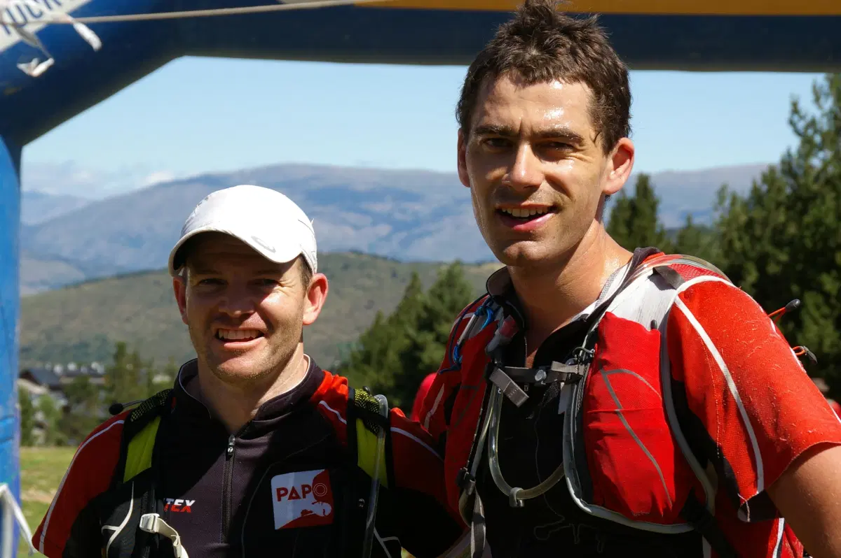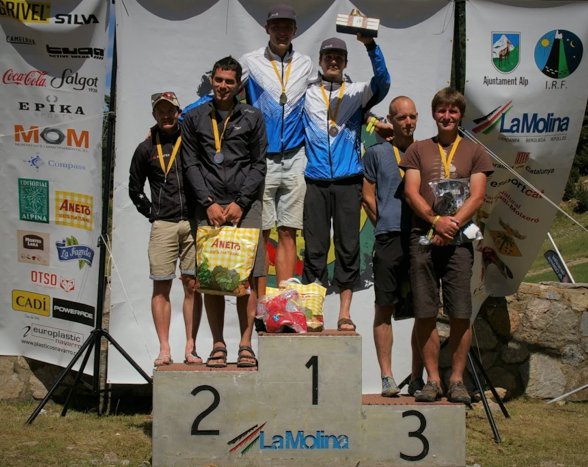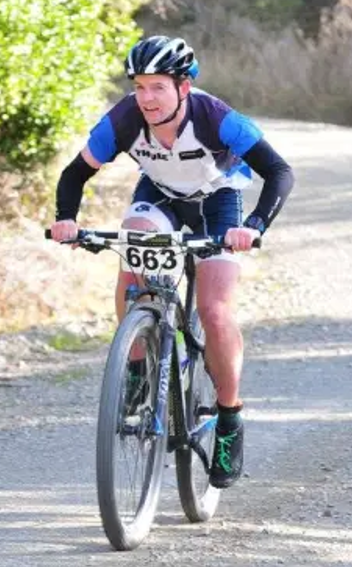
Rogaining is the sport of paradoxes. An integral part of the sport is an appreciation for the natural environment and for the simple things, yet it is full of tech-heads and it utilises sophisticated technology actually developed by some of these tech-heads such as the Navlight scoring system and nswtopo mapping software. It can be a highly competitive activity, yet people will engage in friendly dialogue with teams, out on course and at the end of the event, that they are also desperately trying to beat (and in many cases give them lifts to the event!)
But perhaps the biggest paradox of all is that on the one hand, it is the sport that people can do if they are too young, old or otherwise unable to do more mainstream sports such as rugby, tennis or running. But on the other hand, championship rogaines can be viewed as one of the craziest, physically & mentally demanding activities on the planet. This of course is a key ingredient to making the sport unique.
I consider myself a relatively competitive rogainer. Although there are many others who are more experienced, physically fitter and better at navigation, I rarely enter an event without trying to give 100% physically and particularly mentally. I can say from personal experience that careful training and preparation has inexorably improved my performance at the event. Anecdotal feedback from rogainers everywhere on the competitiveness spectrum indicates that they would like to read about what sort of preparation it takes to achieve the results I have.
But my second place at the NSW Champs and twice 4th place in Australasian Champs is nowhere near the stunning (very narrow) 2nd by Kiwi guns Tane Cambridge and Tim Farrant in last year’s WRC in Spain. Tane has kindly agreed to share insights about his training regime, to provide some ideas for the more mortal person. He also answers a few questions about equipment in conjunction with the “Get Into Gear” series.

Tristan White: What have you studied/trained in and what do you do as a profession?
Tane Cambridge: I studied Mechanical Engineering at the University of Canterbury in Christchurch and am now a Mechanical Engineer at Enphase Energy, so I am involved in the testing and the design of Micro-inverters and the associated accessories.
TW: When/how did you get into rogaining in the first place and approximately (or exactly) how many have you done?
TC: I got into Rogaining through Orienteering. The two sports are pretty closely related and especially here in Christchurch and there is quite a lot of crossover so it’s hard to say when I actually started doing Rogaines! I think I have done about six 24-hour rogaines, no idea how many shorter ones (12,6,3 etc) but would like be over 50?
TW: What other sports have you done?
TC: I’ve been lucky enough to try out a lot of sports. As a kid growing up in Wanaka with parents into the outdoors, I was skiing (downhill and XC) from an early age, sailing (dinghies and trailer-sailers), mountain biking, running, triathlon and climbing (mountain and rock). At school I played team sports such as rugby, cricket and soccer as well as cross-country and orienteering. Now I am still heavily involved in orienteering, running (road, cross-country, trail, mountain), kayaking, cycling, mountain biking, multisport, and adventure racing!
TW: How many countries have you rogained in?
TC: Australia, NZ, Spain & France – the WRC last year in Catalunya had controls in both countries!
TW: What is the most memorable rogaine you’ve ever done?
TC: WRC 2019 – getting 2nd place was an exceptional achievement! We had as close as you could get to a perfect race and it was a fantastic area!

TW: Would you be able to list what you would typically wear and carry in a 24-hour rogaine (excluding shoes), and how much does it weigh at the start?
TC: In a typical NZ rogaine I would take the following:
BASE CLOTHING
- Asics White Cap
- Polarised Sunglasses
- Long sleeve polypropylene top
- Arm Sleeves – to keep sun off arms
- Trimtex Orienteering top, with collar
- Trimtex 3/4 orienteering pants
- La Sportiva Bushido II trail running shoes
- O-speed Gaiters or long orienteering socks
- Underwear
ADDITIONAL CLOTHING
- Jacket – Outdoor Research Helium (light) or Interstellar (heavy)
- Polar Fleece top (in cold or wet weather)
- The North Face waterproof over trousers
- Warm gloves
- Buff
OTHER
- Osprey Duro 15L pack
- Gemini headlamp
- Icebreaker socks
- Thumb compass
- Water bladder and bottle
- Sunscreen
- Anti-chafe
- Survival bag/blanket
- Food*
Typically it would weigh 6-7kg at the commencement of the event
[*- stay hungry for a dedicated article on nutrition later this year. ]TW: How do you modify your clothes and gear based on differing weather & terrain?
TC: If it’s forecast to be wet I will take a heavier weight rain jacket and polypro leggings. If it’s scrubby, I use matagouri/gorse/speargrass Orienteering Gaiters. If it’s farmland with no undergrowth I might wear shorts. In Alice Springs I used Gore-Tex shoes and Tramping Gaiters for the spinifex.
TW: What would a typical month of training consist of for you, particularly in the lead up to a major rogaine?
TC: The weeks usually consist of:
- Mon: Easy run
- Tue: Hill repeats
- Wed: Long run
- Thu: Interval training
- Fri: Easy/rest
- Sat: Fast run
- Sun: Long run
In the last two weeks before a competitive rogaine there would be less long/hard stuff in there, but follow the same rough pattern.
TW: How much training is done with your teammate and how important do you think it is to prepare for big events together?
TC: We are lucky we live in the same city (Christchurch) so we would probably train together once or twice a week. It’s important to be on the same page together and understand each other’s strengths and weaknesses as a team but then the individual side of training or preparation for a big event is important to tailor things to our own levels of fitness and state of recovery. Often it can be difficult to find ideal times to train together – I prefer to train in the evenings after work, while Tim prefers in the mornings before work. So a balance is always good.
TW: What impact do you think your other assortment of sports has on your rogaining performance?
TC: Any long distance type event helps you build the resilience needed for staying up all night and keeping on going when your feet hurt. Orienteering is good for the navigation side of things. Physically speaking, running is good for training the legs, heart and lungs, whereas mountain biking and kayaking are great for building core and balance strength. Aside from that “cross training” is a good break from the day in, day out slog of training, breaking things up and reducing physical strain on one’s body.

TW: Are there any activities that you either avoid or moderate to prevent injury or illness?
TC: Avoiding over-training is super important – you need to have rest days, or low activity days. I like to have a balance of hard and easy training sessions (the very reason why I don’t use Strava!) In the lead-up to any big event I avoid any “extreme” mountain biking – I managed to sprain (possibly fracture) my thumb the week before the World Adventure Racing Champs in 2017 crashing my mountain bike while out training beforehand. I learned my lesson there!
TW: How much overlap is there between rogaining and orienteering training and what differences are there in preparing for them?
TC: The overlap is huge. In Christchurch, there are a lot of opportunities to do both orienteering and rogaining, so I will do both when it suits me. I am still more involved in orienteering than rogaining. The training is pretty much the same, maybe some longer runs are required for the rogaining but the longer training can be beneficial for orienteering too.
The major difference is in the planning that occurs in a rogaine – it is something I have had to work on a lot to get better at choosing which controls to get rather than being told which ones to go to and just doing it as fast as possible. Calculating point and climb rates per kilometre comes into rogaine preparation a lot more than orienteering as you are typically making educated guesses on the spot in the latter. Physical endurance is important to both, but more so in rogaining and speed is more important in orienteering. Efficiency is the key to both!
TW: You know as well as anyone that physical fitness alone is not going to prepare you to be highly competitive in a rogaine. How much of your training includes navigation practice, and aside from other rogaines/orienteering events are there other ways that you practice your navigation?
TC: I would try to incorporate at least 1 or 2 navigation specific training sessions, such as a rogaine or orienteering event, per week. Other ways to practice would be to research the race area, look at maps of the typical terrain old maps of the same area and “armchair” practice. This involves looking at other rogaine maps to plan my own route and analysing other people’s routes in the results. Thanks to fellow Kiwi Peter Squires the Navlight system has made this easily possible!
TW: Do you have any special dietary habits?
TC: I tend to avoid spicy foods, chicken, fish and mushrooms before a race, and to minimise the risk of food poisoning or an upset stomach!
TW: Being able to motivate yourself to keep going throughout the night is tough. Outside of other night events, are there any methods you have to better prepare yourself for the slog of keeping going for 24 hours?
TC: Making sure you are well prepared and well rested beforehand, so that it’s not such a big deal to stay up all night. When I’m getting sleepy, talking about route choice and focusing on the navigation usually is enough to get through the low patches.
TW: Do you have any recovery techniques for after 12/24hr rogaines (stretches, food types, etc), and how long does it take before you feel “normal” again?
TC: First thing is usually food and drink, then sleep! Usually it takes at least 2 weeks to feel normal again.
Thanks for sharing some of your “secrets” Tane! All the best in your future endeavours!
Great article, thanks Tristan and Tane.